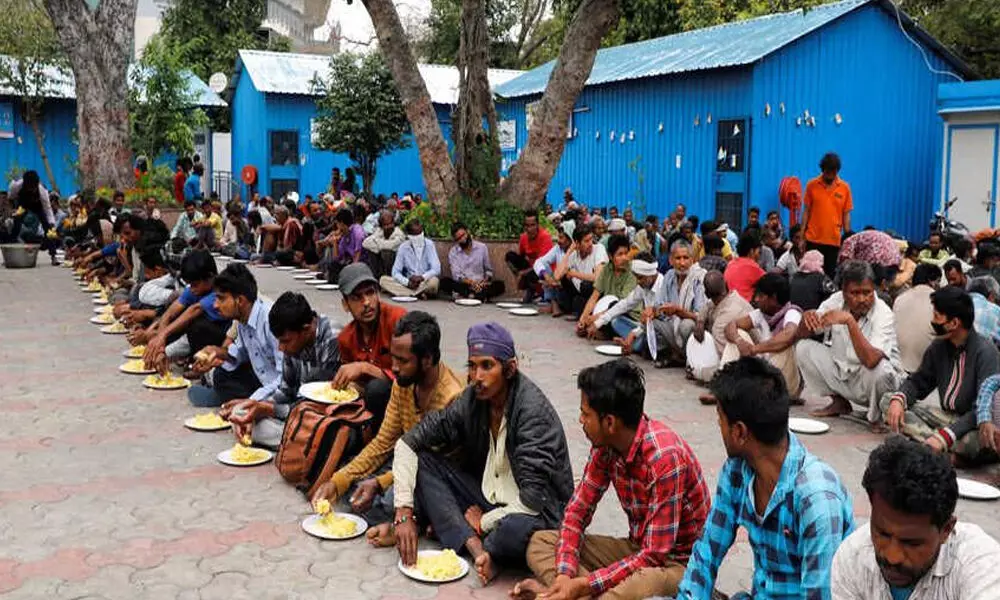Crores of people plunge into poverty in Covid-ravaged India
India's GDP shrank 8% in FY21, its biggest contraction since 1952
image for illustrative purpose

After dipping into his savings to weather India's snap pandemic lockdown last March, Manoj Kumar was just getting his head above water again earning Rs 600 ($8) a day as a construction worker in the tourist hotspot of Goa.
He'd squirreled away enough for a trip last month to his native village in Bihar some 1,490 miles away for a wedding. He's still there, stuck in one of the nation's least developed states, as a fierce second Covid-19 wave triggers the world's worst health crisis and prevents his return. On a lucky day, he'll land some odd jobs that fetch him as much as Rs 300. But there aren't too many of those chores left. So he's taking loans to feed and clothe his wife and three kids.
"It is all in God's hands now," said Kumar, who's told his wife to curtail spending on items such as lentils, cooking oil and clothes. "I don't know when I will return. My family is worried and doesn't want me to go back as the cases are also rising in Goa."
Assessing Recovery
The government estimates India's gross domestic product shrank 8 per cent in the year ended March, its biggest contraction since 1952. Many economists are cutting their forecasts for the current fiscal year as rising unemployment and dwindling savings dim the chances of a double-digit growth. Shaun Roache, chief economist for Asia Pacific at S&P Global Ratings, slashed his prediction to 9.8 per cent from 11 per cent earlier. Fitch Solutions sees the economy expanding by 9.5 per cent, a projection that's below the Bloomberg consensus of around 11 per cent.
"A drawn-out Covid-19 outbreak will impede India's economic recovery," Singapore-based Roache said. "The country already faces a permanent loss of output versus its pre-pandemic path, suggesting a long-term production deficit equivalent to about 10 per cent of GDP."
With the latest surge caused by a new Covid strain, total infections in India have risen to 2.2 crore, a third of which were added just in the past three weeks alone. Daily death count hit a record at 4,187 on Saturday. Experts have warned the crisis has the potential to worsen in the coming weeks, with one model predicting as many as 1,018,879 deaths by the end of July, quadrupling from the current official count of 238,270.
People sit outside Pune railway station during lockdown restrictions imposed by the state government in Pune, Maharashtra, India, on Thursday, May 6, 2021. Serum, the world's largest vaccine maker based in Pune, will deliver 220 million doses to India's vaccine-starved federal and State governments over the next few months, which can cover 8 per cent of the country's population.
Dip in Savings
Economists warn depleting household savings and falling incomes will have an impact on domestic consumption, which accounts for almost 60 per cent of GDP. A study by Nikhil Gupta, an economist at Mumbai-based brokerage Motilal Oswal Financial Services Ltd., found that India's household savings dropped to 22.1 per cent of GDP in the quarter through December, from 28.1 per cent in the three months ended June last year. Full-year numbers show India's savings growth lagged behind the likes of the U.S., the U.K. and Japan, he said.
"A slower rise in household savings, coupled with similar or slower decline in consumption, confirms weak income growth in India," Gupta said. "If so, the contribution of pent-up demand in growth recovery would also be limited in India compared to other nations."
Data showed April jobless rate increased to nearly 8 per cent from 6.5 per cent in March, with more than seven million exiting the workforce last month, according to data from Center for Monitoring Indian Economy Pvt., a private research firm.
Looking for Work
As a result of all the turmoil that started last year, income inequality is deepening in India. A study by Pew Research Center has shown an estimated 7.5 crore people slipped into poverty since the pandemic began. The second wave is set to crush some more. For the study, Pew considered daily incomes of Rs 150 or less as poor, Rs 151 to 750 as low income and Rs 3,750 and above as high income.
A study by the Azim Premji University in Bangalore showed even more alarming numbers. About 230 million individuals slid below the national daily minimum wage threshold of Rs 375 during the pandemic, it said. Though India could still emerge as one of the fastest growing economies in the world, it will also be one of the most unequal countries, Oxfam, a non-profit organization said.
Stephen Schwarzman, chairman of Blackstone Group Inc., said in an interview last month that he's "confident" of the long-term prospects of India. The private-equity firm, which has plowed billions of dollars into the country and owns many of the nation's big office towers, said it would be accelerating its activities in the country. "We will be investing more in the next 10 years than we have invested in the previous period," he said.
Duvvuri Subbarao, a former governor of India's central bank, said the strife faced by the informal-economy workers could hurt India's long-term growth prospects. "Inequalities have intensified because the formal sector has nearly normalized while the informal sector remains distressed," he said. (Bloomberg)

